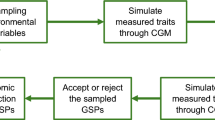Abstract
How many test locations and replications are needed in crop variety trials is a question every plant breeder has to ask. Simple formulas were developed to estimate the optimum number of replicates and test locations. The optimum number of replicates in a trial was estimated by the formula \( {\text{N}}_{{\text{r}}} {\text{ = 3}}\left( {\sigma _{\epsilon }^{{\text{2}}} /\sigma _{{\text{g}}}^{{\text{2}}} } \right) \), where \( \sigma_{\text{g}}^{2} \) and \( \sigma_{\epsilon }^{2} \) are the variance components for genotypic main effect and experimental error in the trial, respectively. The optimum number of test locations for a target region was estimated by \( {\text{N}}_{\text{e}} = 1 + 3\left( {{\raise0.7ex\hbox{${\sigma_{\text{ge}}^{2} }$} \!\mathord{\left/ {\vphantom {{\sigma_{\text{ge}}^{2} } {\sigma_{\text{g}}^{2} }}}\right.\kern-0pt} \!\lower0.7ex\hbox{${\sigma_{\text{g}}^{2} }$}}} \right) \), where \( \sigma_{\text{g}}^{2} \) and \( \sigma_{\text{ge}}^{2} \) are the variance components for genotypic main effect and genotype-by-location interaction, respectively. These formulas were applied to data from the oat registration trials conducted in eastern Canada in 2006–2012. The optimum number of replicates within a trial at the Ottawa site was estimated to be fewer than three for all traits considered. The estimated optimum number of test locations for the whole eastern Canada was fewer than four for all traits except for grain yield and lodging scores. For grain yield, the estimated optimum number of test locations was 20, twice as many as the actual test locations used. Mega-environment analysis using a “GGL+GGE biplot” revealed two distinct subregions in eastern Canada. Analysis within mega-environment revealed that the number of test locations actually used was close to optimal for one mega-environment but severely inadequate for the other.



Similar content being viewed by others
Abbreviations
- G:
-
Genotypic main effect
- GE:
-
Genotype-by-location interaction
- GL:
-
Genotype-by-location interaction
- GS:
-
Genotype-by-subregion interaction
- GGE:
-
G+GE
- GGL:
-
G+GL
- GGS:
-
G+GS
- H:
-
Heritability
- Q:
-
Noise-signal quotient
References
Annicchiarico P, Bellah F, Chiari T (2005) Defining subregions and estimating benefits for a specific-adaptation strategy by breeding programs: a case study. Crop Sci 45:1741–1749
DeLacy IH, Basford KE, Cooper M, Bull JK, McLaren CG (1996) Analysis of multi-environment trials—a historical perspective. In: Cooper M, Hammer GL (eds) Plant adaptation and crop improvement. CAB International, Wallingford, pp 39–124
Hanson WD, Brim CA (1963) Optimal allocation of test material for two-stage testing with an application to evaluation of soybean lines. Crop Sci 3:43–49
Johnson GR (1997) Site-to-site genetic correlations and their implications on breeding zone size and optimum number of progeny test sites for coastal Douglas-fir. Silvae Genetica 46:280–285
Laffont J-L, Wright K, Hanafi M (2013) Genotype plus genotype×block of environments biplots. Crop Sci 53:2332–2341
Littell RC (2006) SAS. Wiley, Ltd
Mi X, Wegenast T, Utz HF, Dhillon BS, Melchinger AE (2011) Best linear unbiased prediction and optimal allocation of test resources in maize breeding with doubled haploids. Theor Appl Genet 123:1–10
Müller BU, Kleinknecht K, Möhring J, Piepho HP (2010) Comparison of spatial models for sugar beet and barley trials. Crop Sci 50:794–802
Snedecor GW, Cochran WG (1967). One-way classifications. Analysis of variance. Statistical methods, 258–298
Sprague GF, Federer WT (1951) A comparison of variance components in corn yield trials. II. Error, year×variety, location×variety and variety components. Agron J 43:535–541
Wricke G, Weber E (1986). Quantitative genetics and selection in plant breeding. Walter de Gruyter
Yan W (2001) GGEbiplot—a windows application for graphical analysis of multi-environment trial data and other types of two-way data. Agron J 93:1111–1118
Yan W (2013) Biplot analysis of incomplete two-way tables. Crop Sci 53:48–57
Yan W (2014a) Crop variety trials: data management and analysis. Wiley, Blackwell
Yan W (2014b) Mega-environment analysis and test location evaluation using unbalanced multiyear data. Crop Sci: in press
Yan W, Holland JB (2010) A heritability-adjusted GGE biplot for test environment evaluation. Euphytica 171(3):355–369
Yan W, Kang MS, Ma B-L, Woods S, Cornelius PL (2007) GGE Biplot versus AMMI analysis of genotype-by-environment data. Crop Sci 47:641–653
Yan W, Frégeau-Reid J, Pageau D, Martin R, Mitchell-Fetch J, Etienne M, Rowsell J, Scott P, Price M, de Haan B, Cummiskey A, Lajeunesse J, Durand J, Sparry E (2010) Identifying essential test locations for oat breeding in eastern Canada. Crop Sci 50:504–515
Yan W, Pageau D, Frégeau-Reid J, Durand J (2011) Assessing the representativeness and repeatability of test locations for genotype evaluation. Crop Sci 51:1603–1610
Acknowledgments
We are grateful to the useful comments and suggestions of two anonymous reviewers. We thank Brad de Haan, Dorothy Sibbitt, Sophie Dionne, Allan Cummiskey, Julie Lajeunesse, Isabelle Morasse, John Rowsell, Peter Scott, Julie Durand, Mark Etienne, Ellen Sparry, and John Kobler for conducting the trials and/or collecting the data used in the case study.
Author information
Authors and Affiliations
Corresponding author
Rights and permissions
About this article
Cite this article
Yan, W., Frégeau-Reid, J., Martin, R. et al. How many test locations and replications are needed in crop variety trials for a target region?. Euphytica 202, 361–372 (2015). https://doi.org/10.1007/s10681-014-1253-7
Received:
Accepted:
Published:
Issue Date:
DOI: https://doi.org/10.1007/s10681-014-1253-7




